Search Results for: F word
Is today’s thriller the best script of the 2021 Black List so far?
Genre: Thriller
Premise: A ride-share driver who’s just purchased his dream car, a 1969 Ford Mercury Cyclone, goes on the Tinder date from hell.
About: Today’s writer, Stefan Jaworski, started writing for TV in Sweden. He has made a few inroads writing here in the U.S., with the TV series, “Those Who Kill,” and the 2021 film, “The Devil Below,” about a group of amateur adventurers who specialize in exploring remote and forsaken places. This script of his landed on last year’s Black List.
Writer: Stefan Jaworski
Details: 92 pages
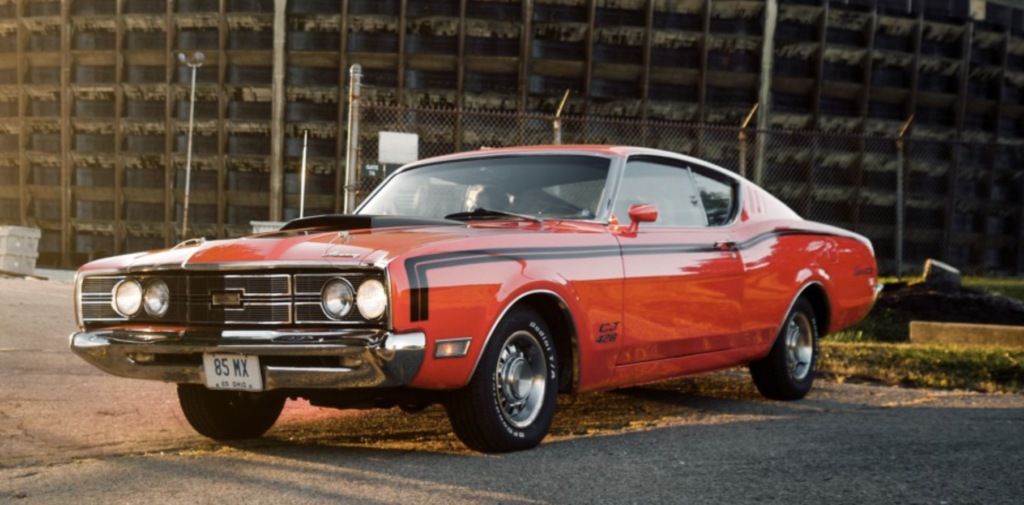
We are BACK on the script review train, checking out a top 10 script from last year’s Black List. I know the writer has been at it for a while as my files show he had a script in circulation all the way back in 2010. This is a long game, everyone! Gotta keep at it.
[NOTE: Spoilery summary – you should probably read the script first!]
Our 20-something lead is Michael Smith, who we meet buying a car, a 1969 Ford Mercury Cyclone, from an old man. I don’t know much about cars but according to our characters’ conversation, the Cyclone was the fastest car you could buy in 1969.
Michael then texts his date, Laura, that he’s coming to pick her up. Laura’s someone he met on Tinder (or Hinge, or Bumble) and they seem to have a great connection. He picks her up in Beverly Hills and they immediately begin some meet-cute dialogue, talking about what sort of superheroes they would be.
After they picnic at Griffith Park, Michael and Laura are engaged in another lovey-dovey conversation while on the freeway when – BAM! – a black SUV rams them from behind. And then – BAM! – rams them again! Concurrently, Laura starts getting all these text-dings on her phone. Michael speeds off the highway and gets to a safe place and stops.
It’s here where Laura comes clean. She has a baaaaad ex-boyfriend. He’s threatened to kill her ever since she left him. He’d disappeared for a while so she thought she was free and clear but I guess not. Laura confides in Michael that she’ll never be able to ditch this guy. He’s too crazy. She’s been planning to escape to this town in Mexico. Maybe tonight needs to be that night.
She’s sorry she got him involved and demands Michael let her go and forget about all this. But Michael is not the kind of guy who leaves a damsel in distress. He will help her escape. What does she need? She’s got to go to three places, she says. Her real house (which is on Skid Row – NOT Beverly Hills), her sister’s, and a friend’s. She needs some personal things before she disappears forever.
But as soon as they’re on the road again, Laura’s ex, Jason, once again comes barreling into the picture, trying to kill them at every turn. When Jason sends a message that if Laura doesn’t surrender, he’s killing everybody she knows, Michael has no choice but to deliver her to Jason’s house.
They show up at the house, head inside, but there’s no Jason. That’s when Laura turns to him and apologizes. Apologize for what, Michael says. For what’s about to happen to you, she says. Michael hears sirens in the distance.
That’s when he realizes he’s been set up. He doesn’t know why. But he knows he has to make a choice in that moment that will change his life forever. And he decides to get in that 1969 Ford Mercury Cyclone… AND ESCAPE AT ALL COSTS. Little does Michael know, his problems are just beginning.
Okay, let’s talk about first acts since First Act March is still going. You probably noticed that, because of the setup, there was no way to first set up our main character’s world. We meet Michael buying his new car. And then we go straight to the date.
This is a good example of the basic challenges you encounter whenever you’re trying to follow a particular screenwriting blueprint. Every story is unique and therefore they don’t all fit the same beat-sheet.
In this case, you have to set up Michael’s world THROUGH DIALOGUE, specially the dialogue of this first date with Laura. That becomes the stand-in for being inside Michael’s world. The good news is that the situation is organic to that information being shared. This is the first meeting between these two. So it makes sense that they’d ask those kinds of questions.
We learn why Michael loves this car so much. That it has a strong connection to his family. We learn that he’s an Uber driver. We learn that he’s a loner and that online dating is new for him. Likewise, we learn things about Laura. In other words, if you can’t get one of these first act components into your screenplay, you have to find substitutions and do the best job you can.
The inciting incident (the SUV ramming them from behind) comes a little late – page 18. That’s even later than usual since the script is only 90 pages long. For a 90 page script, you probably want to hit your inciting incident between pages 10-12. However, the writing is really lean. There’s a lot of dialogue early. And the action lines are 1-2 lines long. So it certainly doesn’t feel like 18 pages have gone by. In fact, that’s a feather in the cap of the entire script, which is written in a really fast fun-to-read style.
We also get the refusal of the call. Michael is tasked with either helping Laura escape or forgetting this night ever existed. And, at first, he decides not to help. But then, of course, he can’t leave her in danger. So he decides to go on the journey. That launches us into the second act, where we get this clever 3-step process that Laura must first execute before she can leave.
I say “clever” because think about it. If all they have to do is get on the 405 south to Mexico, there ain’t a lot you can do plot-wise. By forcing them to zig-zag around Los Angeles, you give the characters more opportunities to run into the bad guys.
In my last newsletter, I spoke about Richter scale moments. Here’s what I said: “The idea behind Richter scale storytelling is simple. Every script needs big moments, moments that “register” with the reader. These are your Richter scale moments, where you hit your reader with plot beats that register 7.0, 8.0, and 9.0 on the Richter scale.”
“Mercury” is one of the best examples I’ve seen of having consistently strong Richter scale moments. Spoilers follow. We get the arrival of the car-bashing crazy ex-boyfriend (8.0 on the Richter scale). We get the moment 40 pages in where we realize she’s set him up (9.0). We get the moment where the mob makes him retrieve what Laura and Jason stole from them (7.5). One after another these Richter scale moments keep coming. It’s great.
Another thing Jaworski does well is he sets up and pays off every single beat of the story. Nothing feels random. For example, there’s this moment in the script where the mob has told Michael that if he doesn’t find their money by sunrise, they’re killing him. And he has NO IDEA where Laura and Jason (who have the money) are. So what does he do?
Jaworski subtly sets up several different times, early on, that Micheal is an Uber driver. And, after Jason rammed into them and Laura came up with that fake plan to get her stuff from her place, she had to confess to him that she didn’t really live in Beverly Hills. She lived near Skid Row and took an Uber to Beverly Hills where he picked her up. He asks why she lied to him and she says, “I was afraid you wouldn’t like me.”
When Michael remembers this moment, he realizes he can use his knowledge and back door access to some Uber information to find out where her Uber originated from, which gives him a destination. There were a ton of moments like this, which were really well thought-through.
And I can hear some of you already saying, “Well, that’s not *that* well thought-through, Carson.” No no no no no. TRUST ME. Read ten other random scripts from this Black List and find me one that puts 10% of the effort into setting up and paying off plot beats that this did. You won’t find one. This has been my biggest beef with the 2021 Black List. Every single script is messy. This is the one script where you can tell the writer actually put in the work.
It’s for all these reasons that, as of this moment, Mercury is the best script of the 2021 Black List. I highly recommend it.
Script link: Mercury
[ ] What the hell did I just read?
[ ] wasn’t for me
[ ] worth the read
[x] impressive
[ ] genius
What I learned: There’s a moment early on in the car (before all the chaos starts) where a song comes on the radio. Here’s how it’s described: “She blinks when the radio shifts to a melancholy POP-ROCK SONG. That echoes loneliness and longing. A favorite of Laura’s.” This is how you introduce music in scripts. Do not give us actual song titles. Everybody likes different music. You may love Britney Spears’ amazing breakout single, “Baby One More Time.” But for others, it is like listening to audio lava. So, instead, give us the genre and the mood of the song, like Jaworski does here. That’s enough to convey the mood you’re looking for.
Genre: Sci-Fi/Drama/Thriller
Premise: (from Black List ) In the year 2065, a fiery teenager with a wild imagination, her paraplegic mom, and their clueless robot struggle to navigate the post-apocalypse; but when the mother’s wheelchair breaks, the trio must venture out into the dangerous “outside” for a chance to survive.
About: Today’s script finished with 11 votes on last year’s “best scripts of the year” Black List. Screenwriter Kryzz Gautier has written and directed a lot of short films. Her biggest credit up to this point is writing the Bioshock 4 video game.
Writer: Kryzz Gautier
Details: 114 pages

We’re going BACK to the Black List. This time for a little first act introspection. Today’s script takes on all of the challenges we’ve discussed about first acts and because the writer seems new to the medium, things get messy. But that’s okay because we’re all just trying to get better here. So let’s take a look!
Wheels Come Off follows 16 year old, Manoella Cortez, who lives in a city I can only assume is New York, a couple of decades after some massive catastrophic event has left the city in shambles.
Manoella spends most of her days with her 2 foot tall robot, Tony, scavenging apartments for food. Sometimes this means stealing from the dead. Sometimes it means stealing from the living. Which Manoella doesn’t feel bad about because she’s got to support her wheelchair-bound mother, Carla.
But when they run out of food, the two must go into the city together to try and accomplish a major food score. Unfortunately, they steal from the leader of a gang, Erick, who makes it his mission to find and kill both mother and daughter (and robot).
Along the way, our heroes meet up with a group of disadvantaged people (one has cerebral palsy, one is deaf, one is blind, etc.) and Manoella falls in love with their leader, a young woman named Ari.
But when Carla’s health deteriorates due to an injury, they must locate the last person she wants to speak to, Manoella’s father, who ran the robot company that may have caused the apocalypse. The extent to which Manoella cares for Carla will be put to the ultimate test when evil Erick figures out where they’re going and is determined to stop them.
Okay, let’s talk about what I liked here. I like that this is based on real life. Kryzz says on the title page that this script is inspired by her real life struggles while taking care of her disabled mother. It’s some of the oldest, yet, most valuable, writing advice you’ll hear: Write what you know. Because when you write what you know, you write specifically. “Specific” is the opposite of “general” which means you avoid writing a generic story.
I also liked the choice to make Manoella and Carla outsized personalities. Both of them were opinionated and talked a lot, which meant a lot of their dialogue was packed with energy.
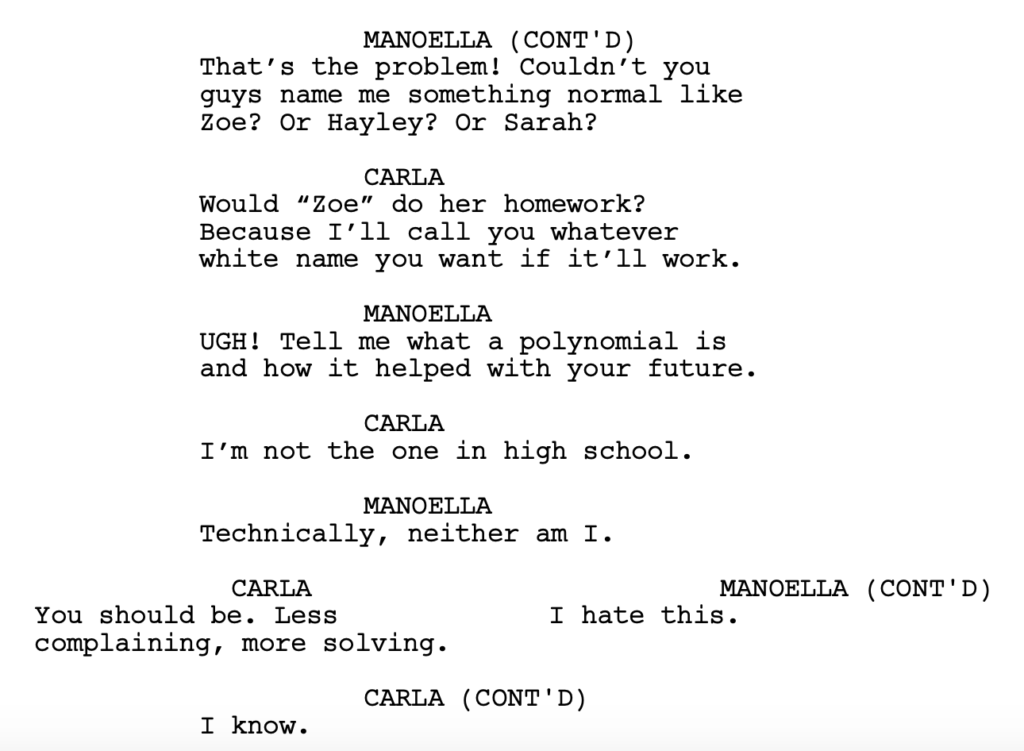
I also felt that, once Kryzz got out of the first act, the script became way more relaxed and free-flowing, which made the pages easier to read.
And that’s where I want to focus today’s review because the weakest part of the script, by far, is the first act. And since we’re talking about first acts this month, it’s a good first act to dissect. The combination of setting everything up as well as not understanding the screenwriting medium made for a bumpy ride that, if I wasn’t reviewing this script, I would’ve checked out by page 10.
Let’s start with the first line of action:
“A pair of legs sneak past wheels then exit an apartment.”
Take a hard look at this line because there’s something wrong with it. See if you can tell me what it is.
Did you figure it out?
The most important detail in the line is left out. What do the legs look like? Are they muscular? Thin? Long? Stubby? Hairy? Smooth? A man’s legs? A woman’s? Old? Young? Any one of those adjectives would’ve given us a much better feel for what was happening. But those details were left out. And this is a common occurrence with beginner screenwriters. The writer assumes the reader can read their mind.
We don’t know what’s in your head unless you tell us.
I must’ve given this advice five times this month on script consultations. Writers continue to think the reader can read their mind. I’m not saying you have to detail everything. I’m saying whatever the most important elements in a scene are, you need to detail those.
Think about it this way. The people watching this movie will be able to answer that question right? They’ll know whether the legs are muscular, thin, long, stubby, hairy, smooth, a man’s, or a woman’s. So why does the reader not get this information? The point of a screenplay is to detail what people are going to see on the screen.
What’s so ironic about this mistake is that it’s the opposite of the writer’s other major mistake in the first act, which is that everything is overwritten. We routinely run into 8 line paragraphs (Try to stay at 3 or less). And there’s a lot of description detailing the same things over and over again (that Manoella steals things from apartments).
We don’t get to the inciting incident until page 28, when Erick catches Manoella stealing a robot battery from his place and vows to kill her and her mom. As we’ve learned this week, you want your inciting incident to happen between pages 12-15 if possible.
Now this is where things get interesting because I suspect Kryzz might push back and say her inciting incident was when Manoella and her mom realize they’re running out of food and have to go find more.
An inciting incident, to me, is an event that is big and has major consequences. I don’t buy that having four days left of food when you’ve already proven to be good at finding food to be a big event with major consequences. I do consider the most dangerous person in the city vowing to kill you a big event with major consequences.
Waiting that long to introduce the story’s most important plot point puts you in a bind because it means you’re setting up character and world for the 27 pages that precede it. And while that may be great for you, the writer, since you have alllllll this space to casually set up your world, it’s terrible for the reader, who is impatiently waiting for the cool stuff to happen.
One of the reasons we stick to these stringent page checkmarks is because it forces you to set up your story faster than you want to. I know that sounds like a bad thing but it’s actually a good thing. Because when you have to set up something in a short amount of time, you think about what’s necessary and what isn’t.
I’ve said this a million times but what makes the pros so much better than the amateurs is that they can do what you do, but in half the pages. Cause anybody can set up a world with enough time. It’s the pros who figure out how to do it quickly and still be effective.
That’s a big part of what writing first acts is. It’s consolidating a bunch of information into a less-than-optimal amount of scenes, and somehow still doing it effectively and entertainingly.
If I’m being 100% honest, Wheels Come Off feels like a script that, five years ago, agents would’ve said, “You’re not ready yet.” There are too many beginner tells (oversized paragraphs, music cues, dream sequences, dual-line dialogue). But I guess now the Black List is prioritizing certain things over script quality that are propping these scripts up and it’s confusing to aspiring writers who have been told that a lot of this stuff isn’t okay.
It’s not that the script is bad. It’s actually quite heartfelt in places. But it reads no different than any of the Amateur Showdown scripts we’ve seen on the site. So I can’t endorse the script. Like almost all of the 2021 Black List scripts I’ve read, it’s messy. It doesn’t feel like the writer has a good grasp on the craft yet.
[ ] What the hell did I just read?
[x] wasn’t for me
[ ] worth the read
[ ] impressive
[ ] genius
What I learned: For those who don’t understand why dream sequences are frowned upon in screenwriting, dream sequences are great for directing and actual production. They allow the director to create striking stylized sequences that are fun to look at. But on the page, all these sequences do is fill up space with words and, at worst, feel pretentious. We can’t see the striking images nor hear the intense soundtrack that make these scenes work. I’m not saying never use them. But in a perfect world, you’d keep them out of your spec script and then, when you get hired for the actual movie, put them in there.
Today we talk about the scariest word in the world: EXPOSITION
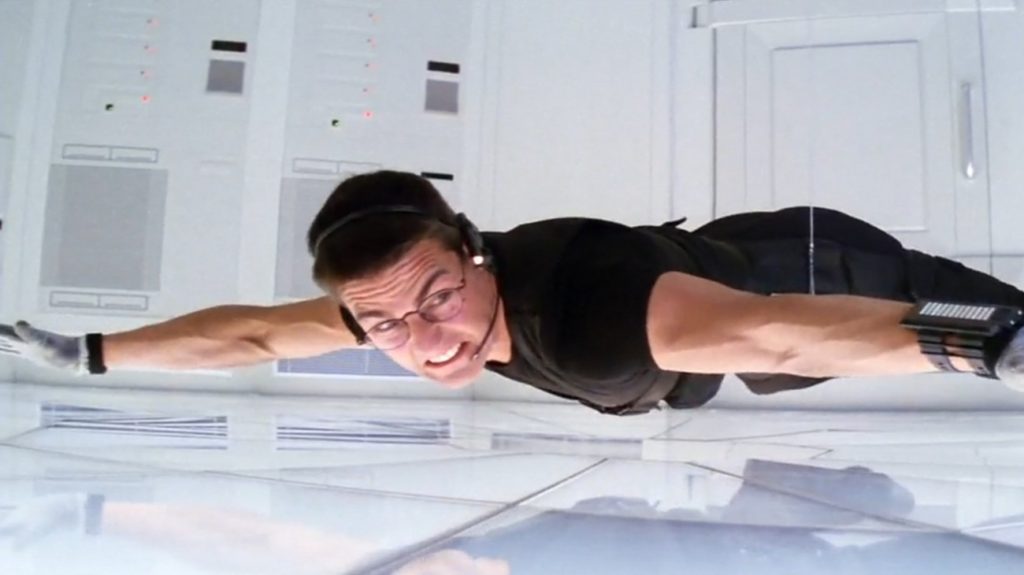
Day 1: Writing a Teaser
Day 2: Introducing Your Hero
Day 3: Setting up Your Hero’s Life
Day 8: Keeping Your Scenes Entertaining
Day 9: The Inciting Incident
Day 10: Refusal of the Call
I don’t talk about exposition nearly as much as I used to. The reason for that is, I find exposition to be very “Screenwriting 101.” It’s one of those things you obsess over as a beginner. And everyone is bad at it for their first five screenplays. But then, a lot like loglines, it’s one of those things where, if you stick around long enough, you figure it out, you know what I mean?
But today we’re going to forgo my reluctance because the first act is all about SETTING UP THE REST OF YOUR MOVIE and that means using a lot of exposition. For those of you new to the medium, exposition is defined as “relevant information about the characters and plot.” If you’re writing a heist movie, like Mission Impossible, all the scenes where the Mission Impossible team discuss how they’re going to break into the computer room – that’s exposition.
Or, if your character needs to pilot a jet in act 3 but there’s nowhere else in the script to fit in any jet-flying scenes, you’ll need some dialogue somewhere that lets your reader know your hero can do this. Han Solo: “And who’s going to fly it kid, you?” Luke Skywalker: “You bet I could! I’m not such a bad pilot myself.” That’s exposition.
You also may need to tell us about where your hero came from and what their current internal situation is, if they’ve had any traumatic experiences recently, like a death in the family, or if they have a drug problem, like Rue in Euphoria. This all falls under the umbrella of exposition. The good news is, you don’t always have to use dialogue to deliver exposition. You can show-don’t-tell. For example, if your hero is an alcoholic, show them drinking a lot in some non-cliche way and we’ll get that they’re an alcoholic.
The reason exposition is such a major focus in the first act is because when a reader comes into a story, they know nothing. You may know everything about your hero and the plot. But the reader doesn’t yet. So everything you tell them is going to be new information. Which means you’re going to have to explain some things. If you introduce a new character, you’re going to have to tell us who they are, what they do, who else they know in the script, how they know them, how they’re relevant to the plot. All of those things require exposition.
Likewise, when the inciting incident occurs in your script, your plot will form. And when your plot forms, you have to disseminate how it forms to the reader. When the Avengers learn that Thanos is going after all the Infinity Stones to snap half of life out of existence, they need to figure out how to stop him. That conversation is all exposition.
One of the things that’s critical to remember is that the story you choose will have a singificant effect on how much exposition you’ll write. If you’re writing a well-known template where the audience knows the rules already and you keep it simple, like, say, “Friends with Benefits,” you’ll have barely any exposition to write. But if you’re writing Lord of the Rings, you’re going to have to explain Middle Earth, 30 characters, what “the ring” is, why it needs to be destroyed, the plan for destroying it, who’s going to try and stop you, all the rules of this world, how the magic works — the amount of exposition is endless.
Another example of a heavy-exposition concept would be Moneyball. You have to explain the rules of baseball. What a general manager does. Who our general manager is. What his specific circumstances are (why is it that his team, the Oakland A’s, is so different from all the other teams in the league?). You have to explain the concept of moneyball (a complicated breakdown of players and stats and how it’s not about flashy stars but rather who gets on base the most). Anybody who’s written one of these scripts will tell you: it’s no picnic.
That’s something you need to take into consideration when you come up with an idea – is how much exposition you’ll be tasked with writing. The more plot, the more characters, and the more world-building there is in your idea, the more exposition-heavy your first act will be.
Okay, sure, we get it, Carson. Exposition is hard. What do we do about it?
What most writers do is take the path of least resistance. They lazily insert the exposition into the first act in a “workmanlike” way, taking the approach of, “Just get it out of the way.” I’m going to anger some readers here, but Christopher Nolan has become famous for this. Between Inception, Interstellar, and Tenet, the man has made an art out of long lazy expository scenes that set up his plot (and world). He didn’t used to do this, by the way. Memento deals with exposition quite elegantly.
The strategy for exposition should be the opposite of this. It should be: Make it as entertaining as you can.
Every time you’re faced with an exposition-heavy scene, ask yourself, “How can I make this as entertaining as possible?” That doesn’t mean you have to stick your lead characters in a car chase and have them dole out important plot points while they’re trying to catch the bad guys (although that’s an option). It just means make the exposition enjoyable instead of boring.
Let’s take Moneyball as an example. Because it has a tall task. It has to explain how the process of moneyball works, which involves the current state of baseball and how moneyball is different and stats and players and blah blah blah. Before I show you how they tackled this, I want you to imagine how you’d write this exposition scene. Because I can tell you how most people would write it.
Billy Beane (Brad Pitt) would be in another GM’s office, and the GM (general manager) would say something like, “Hey, have you heard of this new thing people are doing? They’re using computers to track players now and they’re learning that all the previous stats don’t matter as much as they used to and here’s the stats they do care about, let me list them for you so you understand this new concept of moneyball.” Somebody telling somebody else exposition, unprompted, is one of the worst ways to deliver exposition.
Instead, screenwriting masters Aaron Sorkin and Steve Zallian craft a mystery in regards to moneyball. Billy Beane is in a fellow General Manger’s office where he tries to get the GM to trade him a relatively unknown player, thinking it will be easy. The GM agrees at first, until some nerdy assistant in the corner shakes his head ‘no,’ and the GM goes back on the agreement, telling Billy he can’t trade him. It’s all rather hush-hush and mysterious.
WE’VE GOT OURSELVES A MYSTERY! That’s a great place to be when you need to dole out exposition. Because the reader is curious. “Hmm, what’s going on here?” they think. “I want to know what all the secrecy is about.”
So Billy hunts this nerdy assistant down and says, “Why didn’t you trade me that player?” What I’m about to tell you next is one of the top 5 rules when dealing with exposition: THE ASSISTANT DOESN’T WANT TO TELL HIM. There’s something about a character not wanting to give out the releveant information that cloaks the exposition, making it feel like it’s not exposition. So, here, the assistant can’t tell him because it’s trade secrets. But Billy keeps pushing and pushing until the assistant can’t hold it in anymore. And that’s when he explains how moneyball works.
Never once does the scene feel like exposition because, a) there’s a mystery involved, and b) the assistant only gives out the information reluctantly. Here’s the office scene…
And here’s the big exposition scene that follows…
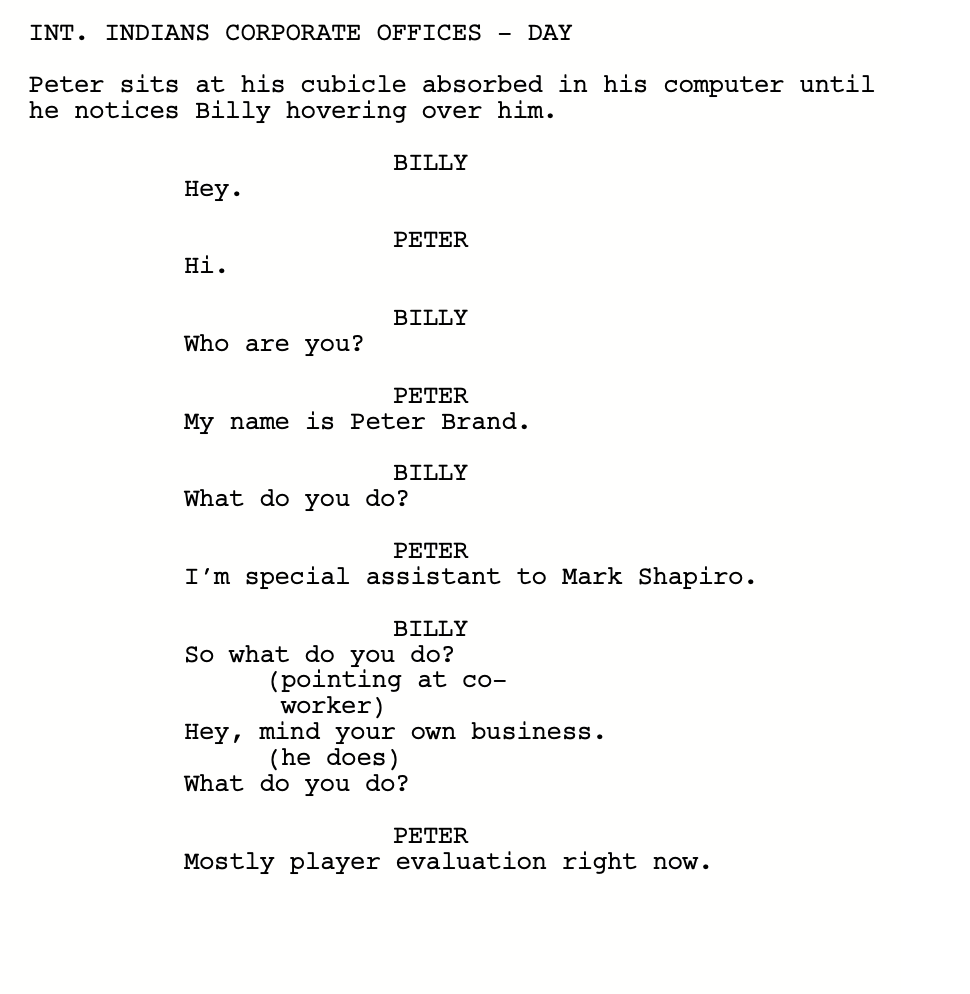
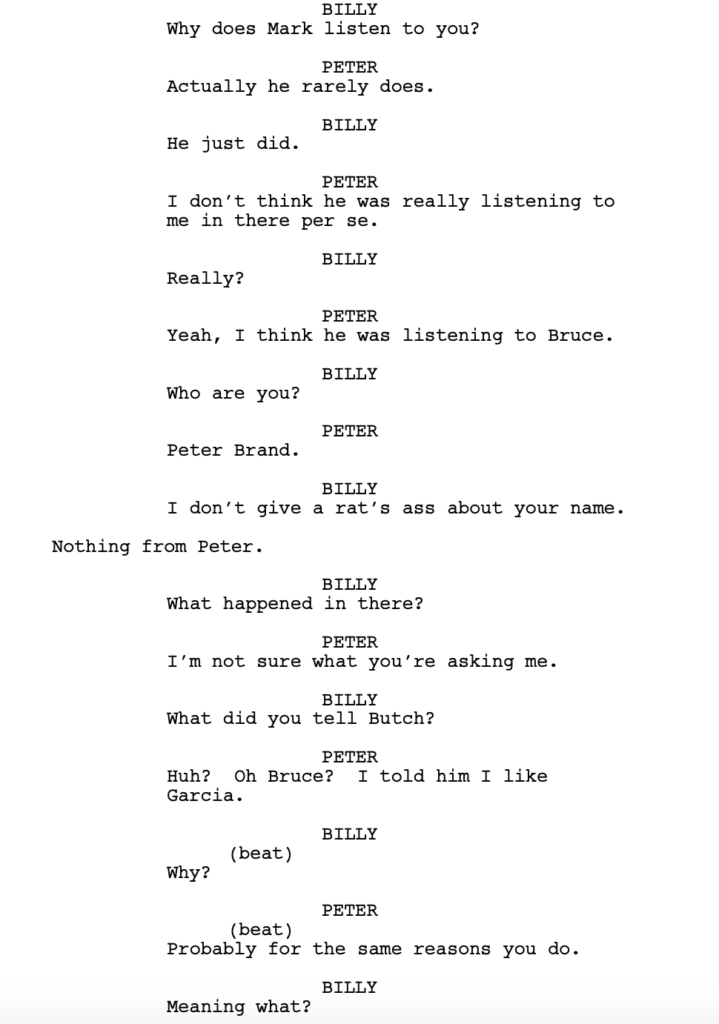
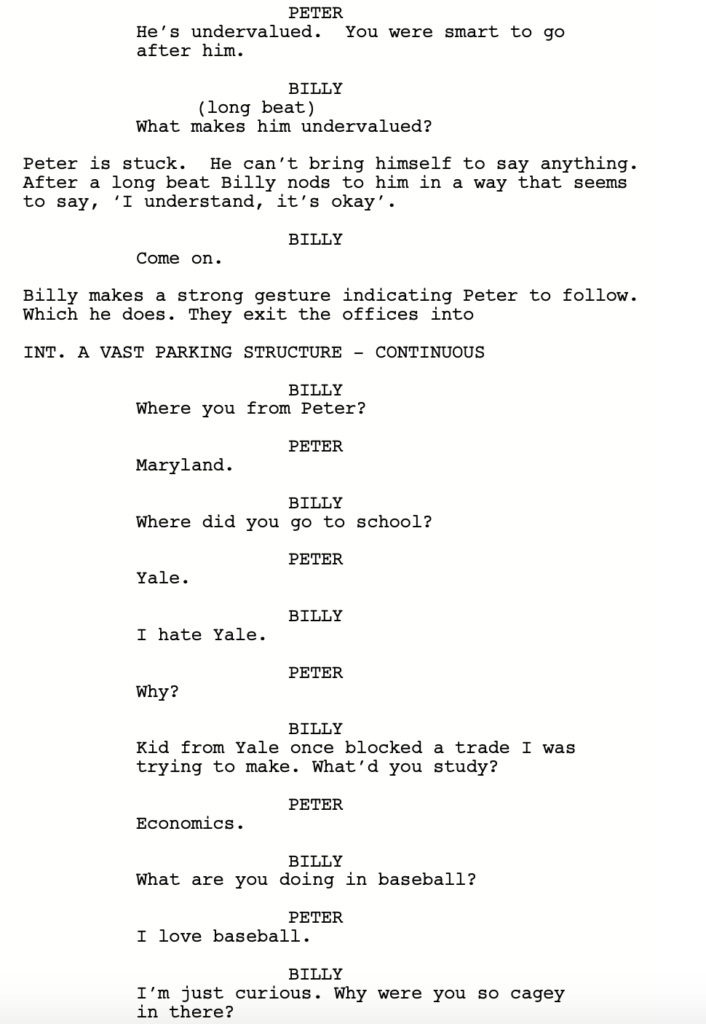
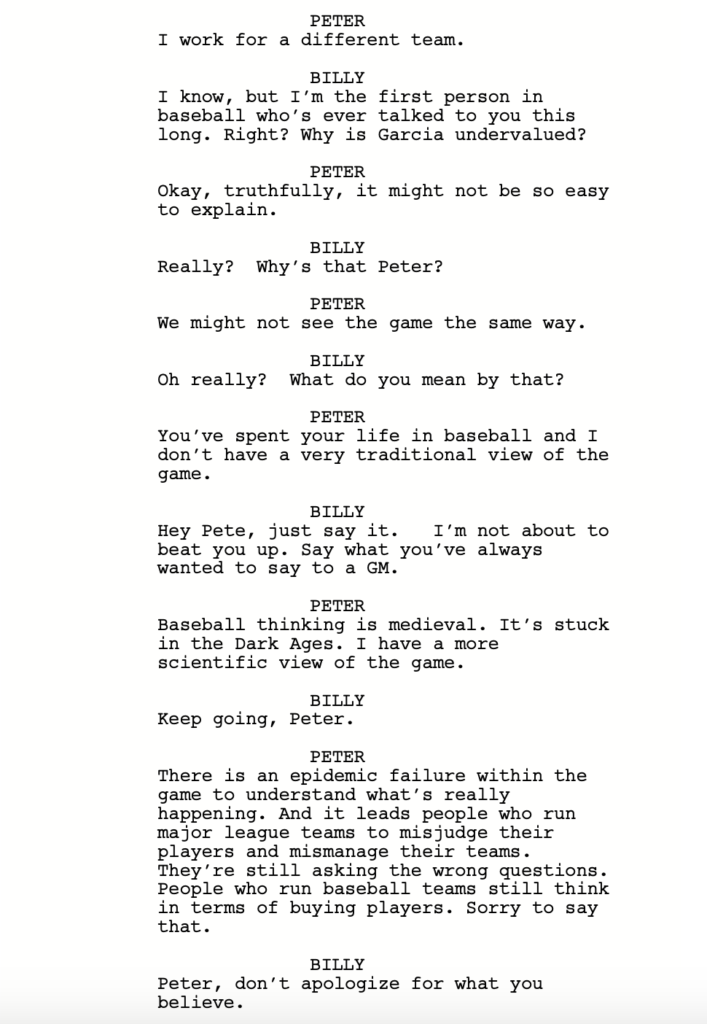
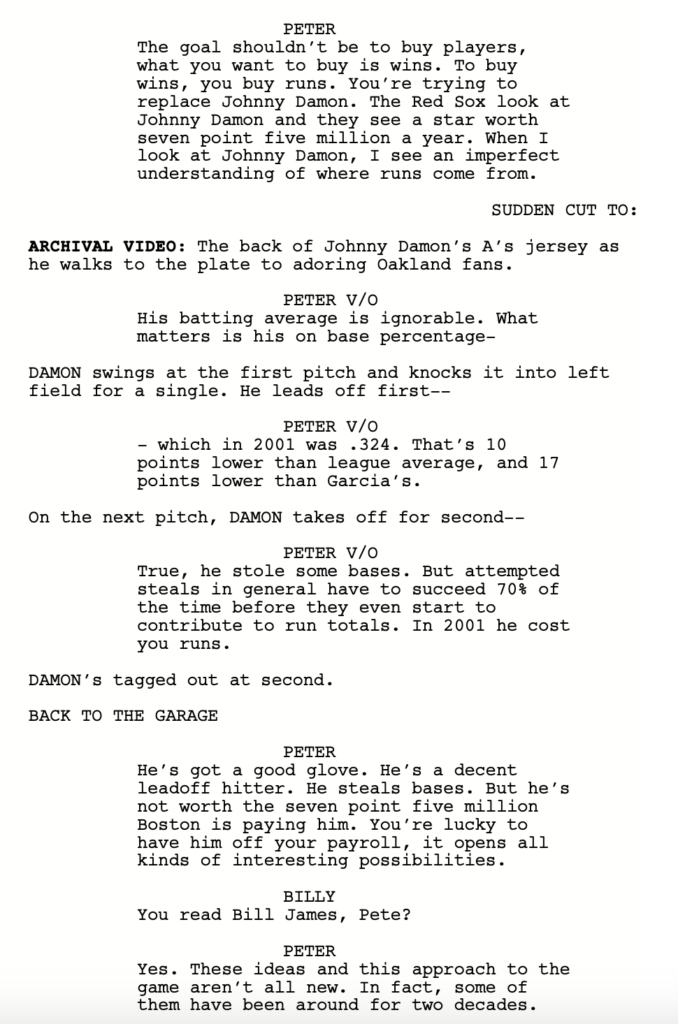
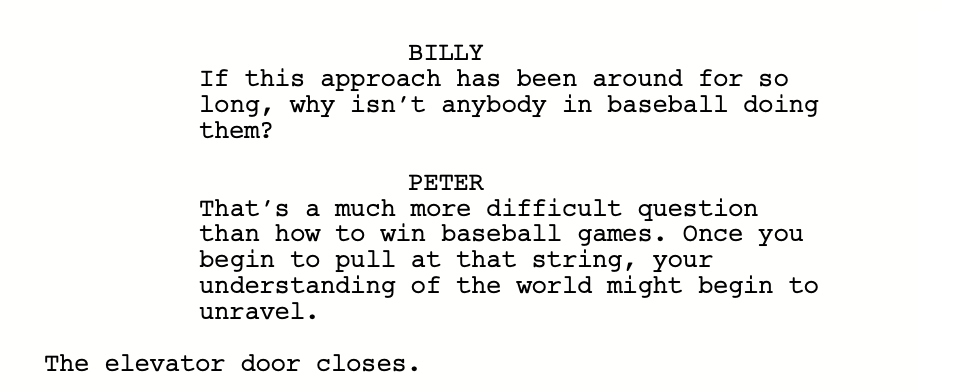
Note the clever twist in the middle of the scene, where he takes him to a more private place. This conveys to the reader that the information he’s about to tell him is secret and valuable. It also adds a little suspense. That’s good writing! I understand that this is a fairly specific example because it’s a sports drama, which not many people are writing. But the approach Steve Zallian uses is the same one you should be using. Which is: “I’ve got a bunch of potentially boring stuff I have to convey to the reader. How do I do so in a dramatically entertaining way?”
More recently, Spider-Man No Way Home dealt with this issue. The film needed to open up the multiverse, a complex concept that needed a lot of explanation, while also explaining that, by doing so, nobody would remember Peter Parker was Spider-Man. I can’t imagine having to come up with a scene that required as much exposition as this one. But the writers did exactly what they were supposed to do: Figure out how to convey this information in an entertaining matter. They do so by having Peter ask Dr. Strange all these questions about what’s going on and how this will affect him WHILE DR. STRANGE IS IN THE PROCESS of executing his spell. Conveying exposition during an exciting moment is a time-tested way to tackle the exposition problem.
As I pointed out in my review of the film, though, the scene didn’t work. It was too jumbled and tried to do too many things at once. But the spirit of what the writers did was correct. They’re giving the viewer exposition through a dramatically entertaining scenario.
In summary, whenever you write a first act, most of your scenes will contain exposition. If it’s a little exposition – try to contain it to as few lines as possible. If it’s a lot of exposition, try to come up with a scene that delivers that exposition in a fun way. Feel free to share your own exposition tricks in the comments! And keep writing those pages!
Next First Act Post: Thursday, March 17
Pages to write until next post: 4
Pages you should have completed by Thursday: 24
Today we discuss the most important scene you will write in your entire script.
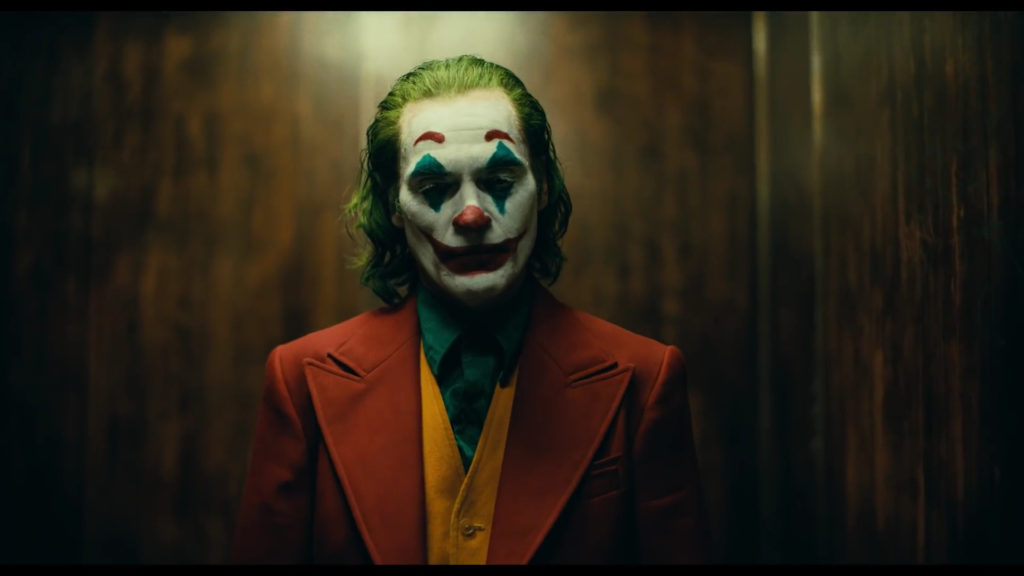
Yesterday, we discussed the teaser scene and talked about whether you should include one in your script or not. Now that you’ve decided, we can move on to either the first scene of the script (if you didn’t include a teaser) or the second scene (if you did). This is going to be your main character’s introductory scene. It is not hyperbole to say this is the most important scene in your script.
The reason for that is the same reason I bring up in half the script reviews I do. Just like nobody in real life wants to hang out with an unlikable person, no audience wants to hang around an unlikable character. So the scene must make us like the hero on some level. I know this word “like” is heavily debated amongst the screenwriting community. The way I define it – insofar as what we’re trying to do – is that you must make us care about the main character enough that we want to root for him.
What’s tricky about this scene is that introducing your hero is only one piece of the puzzle. You also want to introduce their flaw. This is because there are two journeys going on in a screenplay. There’s the external journey, which entails all the physical things we see our hero do to achieve their goal. And there’s the internal journey, which is how your hero changes on the inside while all these external things are happening.
In order for a character to change, you will need to lay out what their starting point is. If they are a selfish person, and their inner journey will show them transform into a selfless person, then it’s imperative you let us know right off the bat that they’re selfish.
On top of establishing likability and a flaw, you will also need to make the scene where they’re being introduced entertaining. A critical mistake a lot of writers make is writing stillborn hero introductory scenes. It’s as if they believe that as long as they set up the character, they’ve done their job. No no no no no no. On top of everything else, the introductory scene itself needs to be entertaining.
This is going to be a theme throughout this month. You don’t get gold stars for setting up characters, setting up plot, or establishing backstory. You only get gold stars when you do all of that stuff IN ADDITION TO entertaining the reader.
So how does one do all of these things in a single scene? The most common way is to show your hero at their job encountering a relatively high-stakes problem. The reason you do this is because a problem necessitates choice and action. Your hero will have to make decisions, which will help us get to know him, and he will need to take action, which gives the scene life.
You see this in a lot of procedurals, cop movies, and serial killer flicks. We meet our hero detective as he arrives at the murder scene. The murder is the “problem.” We need to find out who did it. Or at least find a solid clue that will set us on the right path.
There are a lot of things you can in this scenario to achieve your goals. You can make our detective charming to everyone he encounters, which makes him likable. Or we can make him an underdog. He’s the low guy on the totem pole. Nobody wants him here (everybody likes an underdog so we’re immediately rooting for him). And, of course, he can outsmart the other, more seasoned, detectives, finding the clue that everyone else missed. Since audiences love smart protagonists who are great at their jobs, they immediately like this guy.
These scenes also tend to be entertaining because there’s a mystery component to them. When someone’s been murdered, audiences are curious to find out who did it. They like following someone around who’s trying to answer these questions.
The great thing about generating a problem your hero must solve is that it’s a setup that works for virtually any scenario. If your hero is an office worker, maybe they accidentally deleted their speech and have to give the big boardroom presentation from memory. If they’re a sniper, maybe they’ve been ordered to kill a madman but when they get the target in their sites, there are children in the way, which means they will have to kill the children before they kill the target. If they’re a high school teacher, maybe they’re told by the football coach that they have to reverse a failed test score so that the school’s star player can play in the championship game this weekend.
You’re just looking to put your hero in an unfavorable predicament and see how they respond. That’s the opening to everything from Raiders of the Lost Ark (must escape a crumbling cave) to Toy Story (new Christmas toys arrive to potentially replace the current ones) to The Invisible Man (must escape her evil husband’s home before he wakes up) to The Bourne Identity (a bullet-riddled man is rescued at sea but he has no idea who he is).
Introducing some sort of problem your hero has to face is one of the easiest ways to achieve all the things I talk about in this post.
In order to convey what we’re going for, I’ll highlight the best character introduction I’ve seen in the last five years. That would be the introduction of Arthur Fleck, aka The Joker, in the movie, “Joker.”
The reason I liked this intro so much is because the writer had one hell of an obstacle in front of him. He had to take a psychotic weird unpleasant man and somehow make us root for him. Or at least care about him for the next two hours. Therefore, he constructed this clever opening scene that has our hero getting attacked and humiliated. Remember that audiences will always like characters who are bullied, ganged up on, or taken advantage of. So after this scene, we’re Team Arthur all the way.
I’ve noticed some people online point to this scene as over-the-top and trying too hard to make us like Arthur. I vehemently disagree. This character was going to be so unpleasant for such an extended period of time that the writers had to go big with his introduction. They had to make us really really really care for him. This wasn’t some Adam Sandler movie. This was a disturbed character. We had to massively tip the ‘likability’ scales early on to get people on board.
For those who haven’t seen Joker, here’s the opening scene:

I don’t want to pretend like this is easy. Screenplays are weird in that, sometimes, a story works against what the writer wants to do. For example, maybe your hero is a bank robber. What better way to introduce them than robbing a bank? But what if our bank robber also has a wife and a kid who are going to be a major part of the story? And you start thinking, “I can make my hero a lot more likable if I introduce him around his wife and kid first. And the bank robbery will have higher stakes if we know the hero has a wife and kid waiting at home. So why don’t I set the three of them up in a scene at home first, then send him off to rob the bank.”
In other words, you sacrifice the more entertaining scene – the bank robbery – for a family set-up scene. Is that the right call? Maybe. Maybe not. Funny enough, this is exactly the dilemma Joker faced. In the original script, the opening scene was Arthur meeting with a social worker. The scene did a good job getting into Arthur’s head, making him sympathetic because he obviously has mental issues. But the scene wasn’t entertaining enough to open the movie on. Which is why director Todd Phillips opted to go with the sign-stealing scene instead. It was more entertaining AND it made Arthur sympathetic.
If you can do everything in one scene, you should do it. If not, here’s how I would prioritize the three requirements of an introductory scene.
- MAKE US LIKE HIM! – If we love your hero, we’ll be a lot less finicky about plot and story issues.
- MAKE THE SCENE ENTERTAINING – It’s still early enough in the screenplay that a reader is ready to give up on you. So don’t just introduce your hero. Make sure the scene itself is entertaining.
- INTRODUCE YOUR HERO’S FLAW – While I would prefer to know your hero’s flaw immediately, I don’t think it’s as important as making us like him and making the scene entertaining. If you must hold off on one of these three, you can push the introduction of the hero’s flaw back a scene or two.
Join me back here tomorrow when we talk about secondary characters as well as the scenes you’ll write before the inciting incident.
Next Post: Tomorrow (Thursday, March 3)
Pages to write until next post: 1.5
Genre: Sci-Fi/Drama
Premise: A young woman and her devoted boyfriend’s lives are dramatically altered by a medical procedure that could potentially quadruple their lifespans.
About: Clearly, Matt Kic and Mike Sorce have a love for weird life-extending dramatic sci-fi ideas. They sold a script to Netflix in 2019 called, The Second Life of Ben Haskins, about a guy who gets cancer then goes into stasis until they can transfer his brain into a new body. So this is well-tread territory for them. By the way, these two loved contests before they sold their first screenplay, and the good news for all you aspiring screenwriters out there is, THEY NEVER WON! They semi-finaled a lot. But that’s as far as they got. To be honest, semi-finaling is usually a good sign in contests because often contests want to celebrate an artsy or profound script, which leaves the Hollywood scripts – the cool higher concept ideas – back in the semi-final round. So next time you semi-final in a contest, start looking for houses in the hills cause you’re about to hit it big!
Writers: Matthew Kic & Mike Sorce
Details: 118 pages

Today’s screenplay has a whopper of a twist. But does that twist result in a script worth reading? Let’s find out!
Maddie and Julian, both eight years old, are inseparable ballet dancers. They’re best buddies times a million. After a strenuous day of practice, Maddie gets word that her father is in the hospital. Her mother races Maddie there and her dying dad cryptically tells her not to screw up her life like he did.
Twenty years later, Maddie is still dancing and STILL with Julian. The two are so in love they got matching birdcage tattoos on their wrists. Maddie is a nurse at a place called Dohrnii Medical where she changes bed pans for a guy known as “Gramps,” and has daily battles with protesters, who are mad that Dohrnii offers a new medical procedure to increase your lifespan four-fold.
Maddie, who is still shaken by her father’s death, wants to get the procedure. But to do so would mean becoming sterile. This is something Julian does not accept. He wants to have many kids with Maddie. Maddie is so mad about Julian not wanting the procedure that she goes and bangs her new 40-something dance teacher, Mr. Ford. I’ve seen some rash decisions in my life but that was a little extra, Maddie.
When Julian next leaves town, Maddie secretly gets the procedure, which effectively ends their relationship. Before Maddie can process this, she finds out that her mom is dying. A week later, we’re at the funeral. Right before it starts, Mr. Ford shows up. After exchanging pleasantries, Maddie checks Mr. Ford’s wrist where we see… a birdcage tattoo?
Wait, wtf is going on here? Maddie gets birdcage tattoos with every guy she sleeps with? No. Actually. This is where we learn that Julian, Mr. Ford, and Gramps…. ARE THE SAME PERSON! We’ve been unknowingly jumping back and forth in time throughout the first 30 pages. Since Maddie doesn’t age, we just assumed all of this was happening in the present.
The rest of the script linearly follows Maddie in the year 2025, when she’s a hot mess alcoholic, in 2051, when she tries to conquer her dream of becoming a professional ballet dancer, and in 2083, where she looks back at all the dumb choices she made, particularly the one where she screwed over Julian. In the end, Maddie will learn whether becoming a “jellyfish” was worth it or not.
I think I would’ve titled this, “Hot Mess Jellyfish.” Cause it’s really about a character who is a total mess and has no idea what she wants, navigating her never-ending 20s over the course of 60 years.
I’m not sure how I feel about Jellyfish Days because it’s such a weird script. On the plus side, it’s not like anything else out there. On the minus side, it’s messier than my bedroom all throughout high school. It has these great moments, such as when we realize these three men we’ve been seeing have all been the same guy (Julian). And then it has silly moments, like this whole ‘follow your dream’ ballet storyline, which feels too lightweight for a movie tackling themes as heady as time and aging.
I do like that the script follows my advice of figuring out what’s unique about your concept and building your story around that. Because that’s going to be what separates your script from every other script. What’s unique about this story is that the main character lives for 300 years. So the writers smartly built in this storyline whereby we see all these aspects of Maddie’s life only to later learn they were happening in different time periods. That is a choice SPECIFIC to this concept.
I also thought it was a bold choice to drop that twist on page 30. Most writers would be tempted to save the twist til the end. The problem with saving twists for that long is that you have to lie for too long. You must strategically keep things out of the story that would normally be there. And if you do that enough, the story starts to feel distant, vague.
I’ll give you an example. Early in the script, Maddie and Julian have a fight about her getting the de-aging procedure. The next scene is her running through the rain to Mr. Ford’s house, ringing the doorbell, and when he answers, banging him. When I read that, I hated Maddie. She’s spent her whole life with Julian and all it takes is one argument to send her off having sex with her teacher?? Talk about a cold hearted b-word.
Of course, when we learn Julian and Mr. Ford are the same person, it makes sense. But had they waited until page 120 to tell us that, we would’ve hated her that whole time. And we would’ve been confused. There was nothing between her and Mr. Ford, up until that point in the movie, that would make you think she’d want to be with him. Of course, that’s because the writers can’t tell us too much lest we be onto them.
So it becomes this dance of lies you’re building and building for one shining moment at the end of the film. And while we’ve seen it work – The Sixth Sense – it more often than not doesn’t. So I like that these guys understood that and told us earlier.
I also like that the writers made some bold choices. For example, at first, I was annoyed by all the melodrama. Dad is dying of liver failure. Mom is dying of cancer. Big dramatic divorces are happening. These are the kinds of things you typically see in daytime soap operas. But the more I thought about it, the more I realized that all of this stuff fit the themes of the movie, which came down to the question, “What are the unique things you encounter when you live forever?” And experiencing a lot more heartache than the average person was a logical extension of that theme.
Still, the script is so freaking messy, it’s frustrating. Following your dreams is a subplot for an Addison Rae Netflix movie. It shouldn’t be part of a story trying to make this big profound statement. And then there’s this weird “secret son” storyline that pops up late. Apparently Maddie and Julian had a kid and she gave him up for adoption. But I thought the whole reason they broke up was because she wouldn’t have his kid. I had no idea what was going on there.
With that said, the script is one of those rare instances of something that’s discussion worthy. Yesterday’s script was the anti-discussion worthy script. But this actually has some stuff in it to talk about. And, for that reason, I’d say it’s worth checking out.
[ ] What the hell did I just read?
[ ] wasn’t for me
[x] worth the read
[ ] impressive
[ ] genius
What I learned: This script could’ve used one more plot point. We coasted after page 30, patiently moving through each of the three time periods Maddie lived in. And it got a little boring. An easy place to find a plot point in these high-concept scripts is to use the “and then sh#t goes wrong” tool. If your hero gains the ability to fly, at some point, sh#t needs to go wrong as a result of that power. If your hero gets into Harvard, at some point, sh#t needs to go wrong. If your hero wins the lottery, at some point, sh#t needs to go wrong. Sh#t going wrong is where all the fun is. The writers were so focused on the character side of this equation, they overlooked a potential ‘sh#t goes wrong’ plot point in Jellyfish Days that could’ve spiced up a slow narrative.
